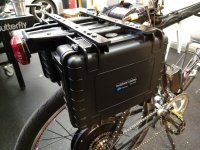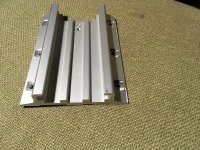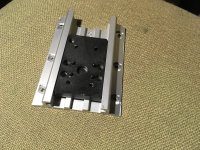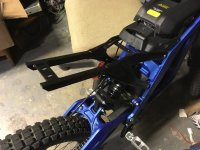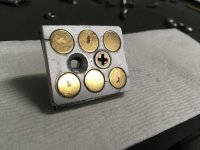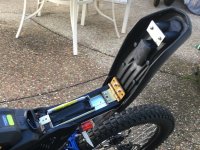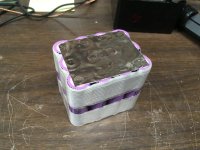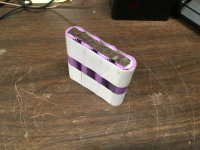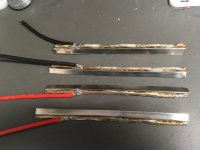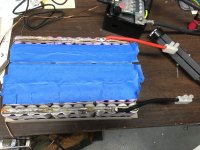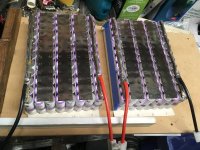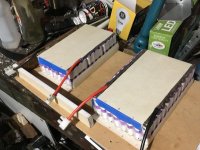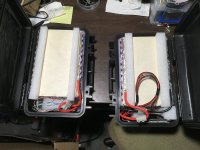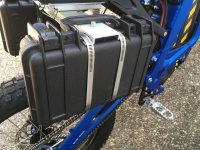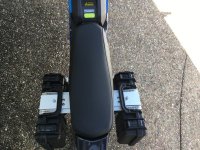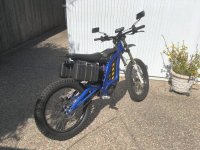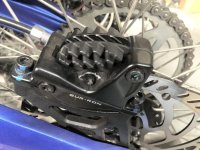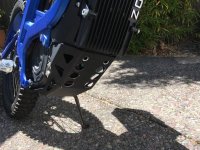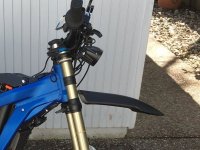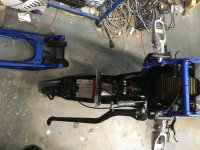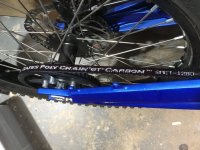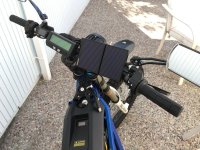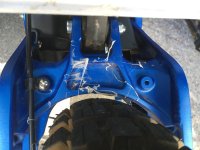The information here was spread out on the other two topics, so I decided to make a dedicated thread for my Sur-ron.
Here's the bike fresh out of the box. It was well crated and did not suffer any noticeable damage from shipping.

The first issue I had was around my house, there isn't anyplace I can legally ride the Sur-ron off road, so I went about installing turn signals, brake lights and mirrors so I could get it licensed as a moped and legally ride on the street. Technically, it's a bit too fast to be a legal moped in sport mode, but in EP mode it would satisfy the requirements in CA. Another issue is it does not have a real VIN number, just a serial number. At least a few people reported success getting a moped plate so I gave it a try. I used the serial number where the VIN goes in the application and made sure to note that it was electric on the application. Well, it worked and about a month later I had a plate.
The Sur-ron has a 12v dc-dc converter for the headlight and tail light which seems to have plenty of extra capacity. Tracing the wires was a challenge but not too hard with a voltmeter.
Below is a schematic of the wiring that is mostly correct:
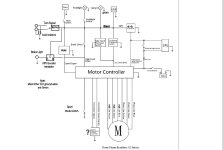
12v goes to the headlight, tail light and brake lever switches in the stock configuration, so I tapped into the wires in the front wire ball under the key. Later I figured out it was easier to just remove the battery and loosen the panel that makes the front of the battery compartment and pull it back for access to the giant hairball of wires.
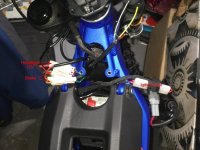
The turn signals and rear tail light were eBay items. For functional turn signals, I had to replace the left side sport mode switch with one that had turn signals.
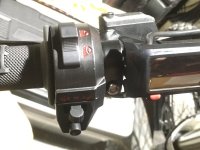
The high/low headlight switch was repurposed to work as the sport mode switch. Now if a picky cop wants to check it out, I just make sure the headlights are on "low beam" and the top speed will be compliant. I took the switch apart and replaced the stock wires with a much skinnier cable made from stranded CAT 5 cable. Since the stock speedometer mounted to the sport mode switch housing, I had to come up with a way to mount that separately.
I sawed off a short piece of aluminum "U" channel and used strong double sticky tape to mount the speedometer to the piece of channel. The channel was drilled with holes for a zip tie to go around the handlebars.
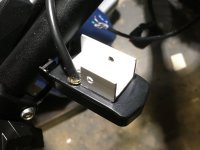
This allows the speedometer to be placed anywhere on the bars and has the added feature of being easily adjusted for angle. I found this to be very useful when riding in the sun where often the stock position was difficult to read. I highly recommend this mod. Another benefit is in the event of an impact, the speedometer will just spin on the bars instead of breaking off.
The front turn signal lights are a strip of LEDs that wraps around the top of the forks.
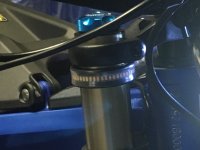
They have a dual color function so shine white as running lights when not signalling. These were impressively bright and are easily seen during the day. I used a long skinny zip tie through the channel of the LED strip to keep it secured to the fork.

I used a solid state flasher made for LED lights. But it did not work properly without adding resistors across the LED lights. Something like 100-150 ohms made it work properly.
For the rear, I found a brake/tail/turn signal light with everything integrated along with a plate holder. I made an angle bracket from some scrap aluminum so I could mount it to the stock tail light holes.
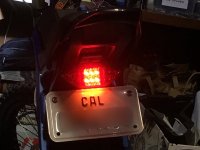
Parts I used (as far as I can remember):
Rear combination brake/tail/turn signal/plate holder
https://www.ebay.com/itm/12V-red-20...e=STRK:MEBIDX:IT&_trksid=p2060353.m2749.l2649
Front fork mounted turn signal lights
https://www.ebay.com/itm/2pcs-Switc...875501?hash=item1a309efced:g:lK0AAOSwcIxdP-6s
Handlebar mounted switches
https://www.ebay.com/itm/2x-7-8-Uni...e=STRK:MEBIDX:IT&_trksid=p2060353.m2749.l2649
LED flasher module
https://www.ebay.com/itm/Two-Pin-LE...763899?hash=item3b25979e3b:g:VCoAAOSwXMxcG-dq
OK, now I could start riding it around!
I quickly figured out that the stock knobby tires were not really good for the street and I wanted fatter tires anyway.
For the front, I found a Shinko SR241 in 2.75 x 19. This just barely fits with a few mm of clearance to the fork. I was warned by someone else to snip off the little mold sprue rubber thingys that stick out on the side of the tire. Even after just one ride, those things had sawed a nice notch in my fork.
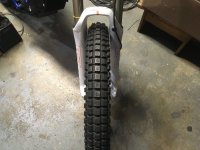
For the rear, the next wider tire in a Shinko was 3.5", which I figured might be too wide, which would suck. As a compromise, I found a Duro in 3.25 x 19 with a matching trials tread. The Duro fits with a good amount of clearance on the sides. A 3.5" might just barely fit, but I'm happy with the 3.25"
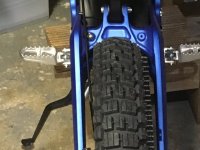
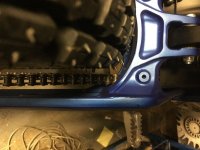
Here's the bike fresh out of the box. It was well crated and did not suffer any noticeable damage from shipping.

The first issue I had was around my house, there isn't anyplace I can legally ride the Sur-ron off road, so I went about installing turn signals, brake lights and mirrors so I could get it licensed as a moped and legally ride on the street. Technically, it's a bit too fast to be a legal moped in sport mode, but in EP mode it would satisfy the requirements in CA. Another issue is it does not have a real VIN number, just a serial number. At least a few people reported success getting a moped plate so I gave it a try. I used the serial number where the VIN goes in the application and made sure to note that it was electric on the application. Well, it worked and about a month later I had a plate.
The Sur-ron has a 12v dc-dc converter for the headlight and tail light which seems to have plenty of extra capacity. Tracing the wires was a challenge but not too hard with a voltmeter.
Below is a schematic of the wiring that is mostly correct:

12v goes to the headlight, tail light and brake lever switches in the stock configuration, so I tapped into the wires in the front wire ball under the key. Later I figured out it was easier to just remove the battery and loosen the panel that makes the front of the battery compartment and pull it back for access to the giant hairball of wires.

The turn signals and rear tail light were eBay items. For functional turn signals, I had to replace the left side sport mode switch with one that had turn signals.

The high/low headlight switch was repurposed to work as the sport mode switch. Now if a picky cop wants to check it out, I just make sure the headlights are on "low beam" and the top speed will be compliant. I took the switch apart and replaced the stock wires with a much skinnier cable made from stranded CAT 5 cable. Since the stock speedometer mounted to the sport mode switch housing, I had to come up with a way to mount that separately.
I sawed off a short piece of aluminum "U" channel and used strong double sticky tape to mount the speedometer to the piece of channel. The channel was drilled with holes for a zip tie to go around the handlebars.

This allows the speedometer to be placed anywhere on the bars and has the added feature of being easily adjusted for angle. I found this to be very useful when riding in the sun where often the stock position was difficult to read. I highly recommend this mod. Another benefit is in the event of an impact, the speedometer will just spin on the bars instead of breaking off.
The front turn signal lights are a strip of LEDs that wraps around the top of the forks.

They have a dual color function so shine white as running lights when not signalling. These were impressively bright and are easily seen during the day. I used a long skinny zip tie through the channel of the LED strip to keep it secured to the fork.

I used a solid state flasher made for LED lights. But it did not work properly without adding resistors across the LED lights. Something like 100-150 ohms made it work properly.
For the rear, I found a brake/tail/turn signal light with everything integrated along with a plate holder. I made an angle bracket from some scrap aluminum so I could mount it to the stock tail light holes.

Parts I used (as far as I can remember):
Rear combination brake/tail/turn signal/plate holder
https://www.ebay.com/itm/12V-red-20...e=STRK:MEBIDX:IT&_trksid=p2060353.m2749.l2649
Front fork mounted turn signal lights
https://www.ebay.com/itm/2pcs-Switc...875501?hash=item1a309efced:g:lK0AAOSwcIxdP-6s
Handlebar mounted switches
https://www.ebay.com/itm/2x-7-8-Uni...e=STRK:MEBIDX:IT&_trksid=p2060353.m2749.l2649
LED flasher module
https://www.ebay.com/itm/Two-Pin-LE...763899?hash=item3b25979e3b:g:VCoAAOSwXMxcG-dq
OK, now I could start riding it around!
I quickly figured out that the stock knobby tires were not really good for the street and I wanted fatter tires anyway.
For the front, I found a Shinko SR241 in 2.75 x 19. This just barely fits with a few mm of clearance to the fork. I was warned by someone else to snip off the little mold sprue rubber thingys that stick out on the side of the tire. Even after just one ride, those things had sawed a nice notch in my fork.

For the rear, the next wider tire in a Shinko was 3.5", which I figured might be too wide, which would suck. As a compromise, I found a Duro in 3.25 x 19 with a matching trials tread. The Duro fits with a good amount of clearance on the sides. A 3.5" might just barely fit, but I'm happy with the 3.25"




